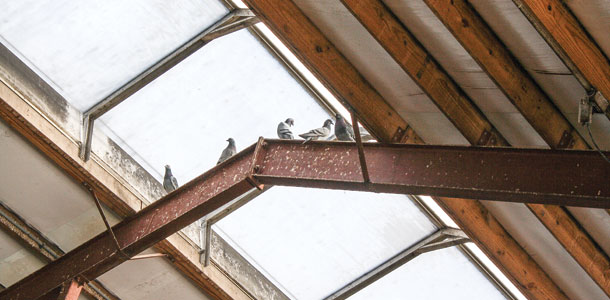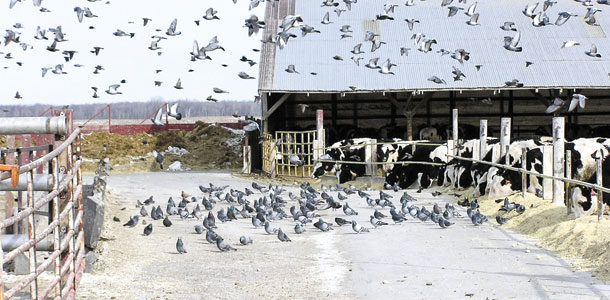Dairy barns aren’t meant to be havens for birds. While European starlings are often the most visible and destructive birds on dairy farms, they typically don’t present a year-round concern. But other birds do.
Large flocks of starlings will happily gain access to your barn come cool weather, enjoying the shelter and using the feed pile as their primary food source, which they complement with the livestock’s water. Come spring, however, the flocks of starlings break up into nesting pairs, leaving the barn for more suitable sites.
“The issue (of starlings) is mostly in the wintertime. They’re roosting in the winter in large flocks,” according to Charles “Chip” Lovell, district supervisor/certified wildlife biologist, USDA-APHIS, wildlife services in Wisconsin. “The problem most farms are seeing in the spring and summer are nesting birds.”
While starlings are notable for their sheer numbers and repeat return come cold weather, two other non-native bird species are “year-round residents” at dairy farms. House sparrows (also known as English sparrows) and pigeons (rock doves) are barn nesters and permanent residents. Unless discouraged, their populations can continue to grow, Lovell emphasizes.
How to get birds to ‘fly the coop’
The presence of a few nesting pairs of birds may not seem significant. Since the bird population in warm weather is dramatically decreased from the winter’s large starling flocks, farmers may not realize their barn has become a year-round home for birds.
Once established, these resident birds aren’t going to fly the coop easily. While disease pressures tend to be lower in warm weather, with exposure to sunlight and increased warmth making the environment less conducive to pathogens, as the density of the bird population grows, so too will any adverse effects, Lovell warns.
The best defense is to take measures to make the neighborhood less desirable for the birds. Preventing birds from nesting is the most effective means of eliminating them. Seal off building access, including small holes and gaps that allow birds to enter.
Plastic strips hanging down in doorways will allow equipment and people access while keeping birds out. Netting can be very effective in excluding birds from rafters so they can’t nest even in open-air structures.

House sparrows are cavity nesters, as are starlings, and will seek out holes or openings in the roof area. House sparrows also like to nest behind shutters. Both sparrows and starlings will also nest in bluebird boxes, so removing any from the barn area is prudent. Pigeons prefer a flat spot, often on rafters or shelves in building crevices.
“Once the birds are nesting, it is difficult to get rid of them,” Lovell says.
If house sparrows and pigeons have established their homes, they have nowhere else to go and will be reluctant to leave. House sparrows nest from April to July, while pigeons breed year-round. Starlings are done nesting by fall, when they then return to winter shelter in the barn.
Anti-perching devices can be helpful in discouraging nesting. Common nesting deterrents recommended by Penn State Extension include tilting the rafters to a 45-degree angle, installing simple mechanical perch repellents (which consist of sharp wires and can work for larger species), utilizing electronic devices that provide a shock to the birds on nesting surfaces or using chemical repellents that make the nesting site sticky or slippery.
Other bird control measures
Use of harassment devices to prevent initial nesting of year-round residents or to deter flocks of starlings in the fall when they are returning to seek winter shelter can have some limited effect if timed correctly. But these visual scare deterrents or audio recordings of hawk screeches “typically aren’t real effective long term,” Lovell cautions.
The presence of a resident hawk can drastically reduce the nuisance bird population, should one happen to make your barnyard its home, but there isn’t really any way farmers can entice a hawk to claim the area as its territory.
A possibility for farms faced with severe bird problems would be to hire a falconer. Much like orchardists use a falconer to deter birds from consuming the ripening crop before it can be harvested, the use of falcons could be timed to prevent the starling flocks from finding a winter home in the barn.
Whether or not this is cost-effective would depend upon the loss of feed, the prevalence of disease concerns and the more permanent solution of sealing the building or eliminating nesting and roosting sites, Lovell says.

Any measure to keep feed and water inaccessible to birds can help make the barn less hospitable. Pigeons, house sparrows and starlings will all eat a variety of foods, with grain and seeds being an important part of their diets. They consume insects and garbage as well.
Using decoy traps can be an effective measure. Traps will need to be baited and maintained, and birds will need to be humanely euthanized. Pigeons, starlings and house sparrows are not protected under federal law.
Some states may require a permit, however. Shooting individual birds may work if their numbers are low. There are EPA-approved toxins for use outside of livestock feeding areas, but they aren’t that effective for pigeons and getting birds to eat the toxin is not always successful.
This would be an option with very large populations, according to Lovell. With lethal methods, there is a concern that non-targeted species can be affected.
Aside from disease concerns for humans and livestock, birds also consume livestock feed and impact farm profitability. Lovell adds that bird droppings are acidic and can shorten the life of equipment.
Other on-farm bird concerns are less common. They include predation by the aggressive black vulture, which can be a problem during pasture birthing, particularly in southern states. And herring gulls, known for following tractors during tillage and getting caught in manure pits, can also be a nuisance.
Don’t let your dairy go to the birds. Gaining control will depend upon the current population of nuisance birds and their predominant species. If a substantial problem already exists, decoy traps or approved toxins can be effective in population reduction.
If the bird pressure is minimal, targeting individual birds may work. But permanent measures to eliminate bird entry, nesting or roosting, and to eliminate access to food and water, are the only real solutions for year-round bird control on the dairy farm. PD
Tamara Scully, a freelance writer based in northwestern New Jersey, specializes in agricultural and food systems topics.
ADDITIONAL RESOURCES
View these additional resources for dealing with birds on your dairy.
• Connect with an USDA-APHIS Wisconsin state office by calling 1-866-4USDA-WS (1-866-487-3297).
• Read through this Penn State extension article, "Controlling birds around farm buildings," to identify types of birds and advice for managing them.
• Learn about managing birds in winter in the 2014 article, "Bye, bye birdy: Get a head start to manage winter bird problems."
PHOTOS
TOP: Photo courtesy USDA, Wildlife Services.
MIDDLE: Bird droppings pose a risk to animal health, particularly when found in areas where cattle eat. Photo by PD staff.
BOTTOM: Pigeon problems tend to be year-round as opposed to seasonal. These birds look for flat spots or crevices in barns to build their nests. Photo by PD staff.






